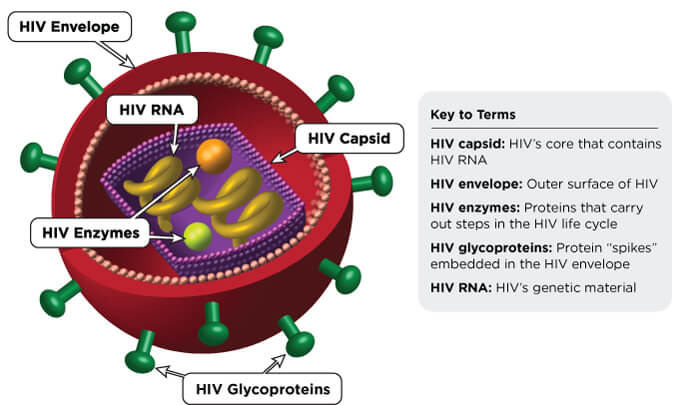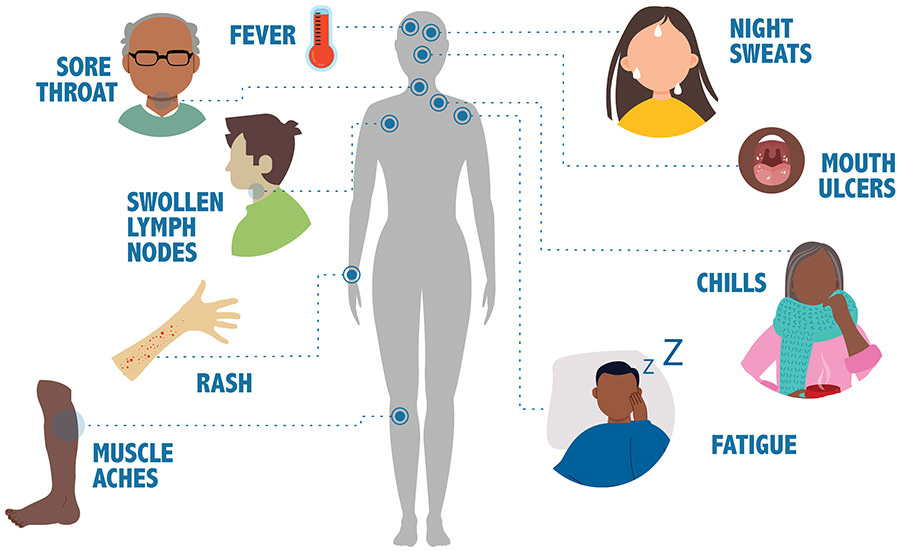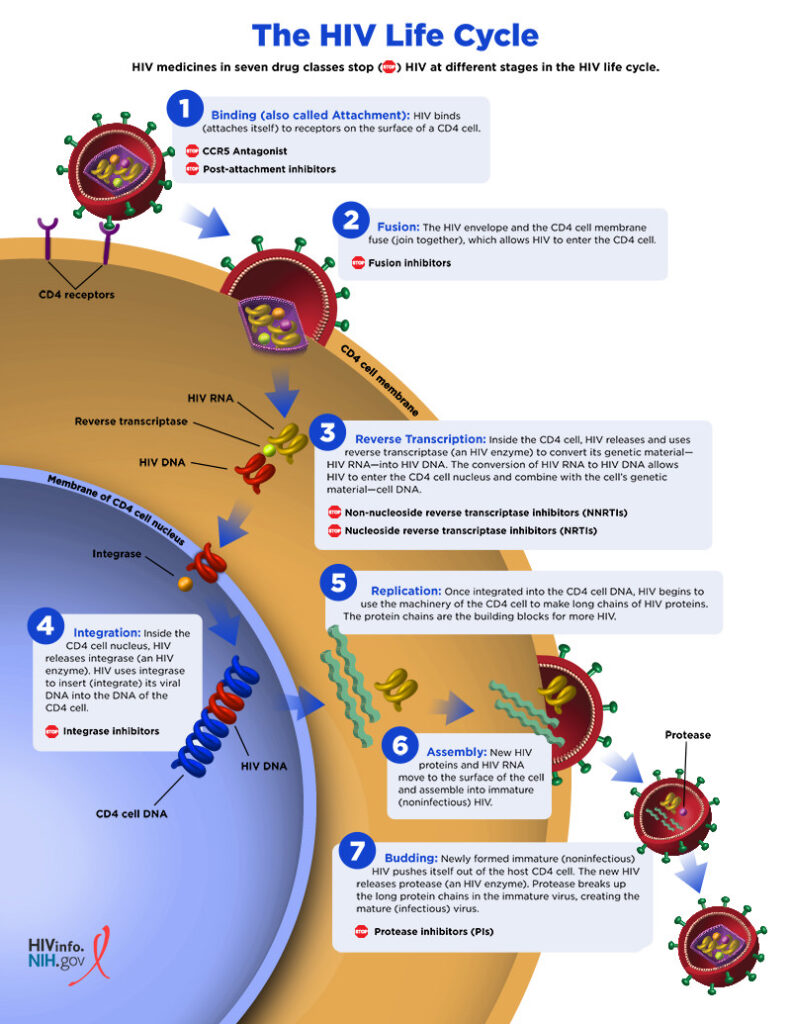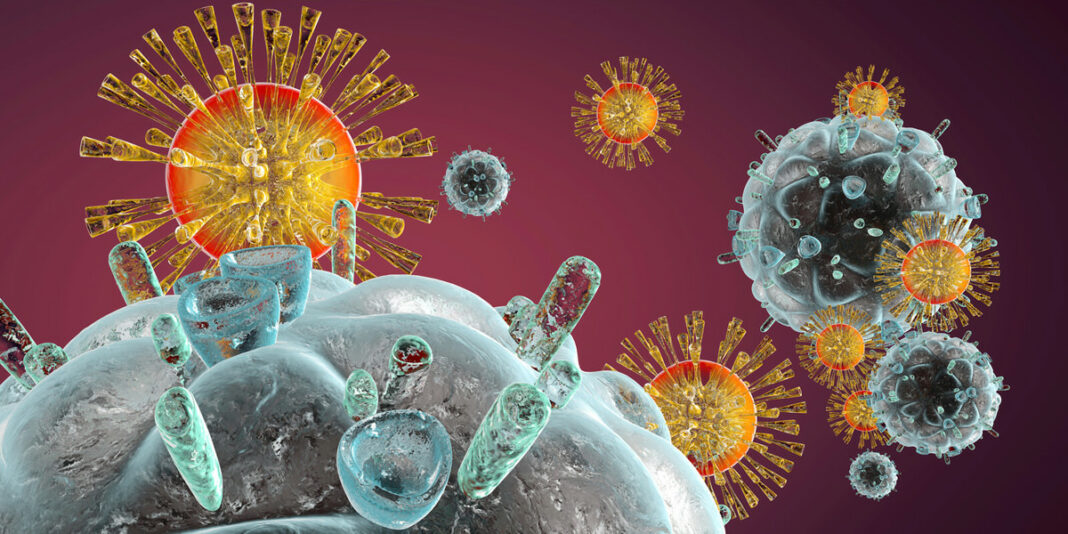In the pursuit of deliberately becoming infected with Human Immunodeficiency Virus (HIV), bug chasers can feel anxious or even excited by the seroconversion process, along with feeling a number of other emotions. The symptoms experienced when seroconverting can vary from person to person, but are usually noticeable between 2 to 4 weeks after infection, which is known as the acute HIV infection stage. Typical symptoms include a fever, chills, muscle aches, swollen lymph nodes, rashes and fatigue, which can also be common symptoms for other health conditions.
A person might not become infected with HIV the first time they are exposed to the virus and the chances of success can vary considerably based on certain conditions. According to the Centers for Disease Control and Prevention (CDC), the estimated probability of acquiring HIV from an infected source for receptive bareback anal sex is 138 cases per 10,000 exposures, or 1.38% and for insertive bareback anal sex is 11 cases per 10,000 exposures, or 0.11%. While these numbers might seem extremely low for those who are trying to convert, there’s a number of factors that can affect these figures, such as the presence of sexually transmitted infections, acute and late-stage HIV infection and high viral load that can boost these numbers significantly.
The CDC offers an HIV risk estimator tool, so if you want to explore the risk factors more intricately, this estimator is an excellent tool and I have explored some of the factors that fall into the high risk and extreme risk categories using the data that’s currently available. I have only included the data that involves barebacking and no medication, whether this is PrEP for those who are HIV-negative or ART for those who are HIV-positive. There is a link to the estimator tool at the end of this article if you are interested in estimating particular scenarios including PrEP, condoms and ART, so you can tailor the data to your own needs to see the risk factors for additional situations.
| Risk Factor | Type of Sexual Position and Health Situation |
|---|---|
| 11 | Insertive anal sex + HIV |
| 29 | Insertive anal sex + HIV + STD |
| 77 | Insertive anal sex + HV + STD |
| 80 | Insertive anal sex + acute HIV infection |
| 138 | Receptive anal sex + HIV |
| 211 | Insertive anal sex + an STD + acute HIV infection |
| 366 | Receptive anal sex + HIV + STD |
| 1001 | Receptive anal sex + acute HIV infection |
| 2651 | Receptive anal sex + STD + acute HIV infection |
HIV is transmitted through body fluids, including blood, semen (cum), pre-seminal fluid (pre-cum), rectal fluids and for women, vaginal fluids and breast milk. These fluids must come into contact with a mucous membrane or damaged tissue or be directly injected into the bloodstream for transmission to occur. Most of the body’s surfaces feature dry skin, such as our arms and legs, so these surfaces don’t allow HIV to enter the body, unless a cut or sore is present, which is why HIV is primarily transmitted via particular areas of the body.

For HIV to enter our body, the virus needs a certain skin type, which is wet skin, known as mucous membranes. The mucous membranes are vulnerable to HIV and make it easier for HIV to enter the body. The wet skin involved in the transmission of HIV includes the foreskin and urethra on the penis, the anus and rectum, the mouth and throat and the cervix and vagina for women. Dry skin is covered with a protective layer of fibres that HIV cannot penetrate, unless there is a cut or sore present, but mucous membranes are not covered with the same protective layer of fibres, because it would hinder functionality, so this is the route HIV uses to enter our body.
You might be thinking that one load of high-viral cum flooding the anus through sexual intercourse might be enough to penetrate our body, which in some cases it is, but our body still has some tricks up its sleeve to fight off the virus before it enters the body. The mucous membranes are covered with a layer of cells that are tightly joined together and designed to help prevent germs from entering our body and causing an infection. The rectum has a single layer of cells, but the foreskin, urethra, mouth and vagina have multiple layers, which is why infection through receptive anal sex is more common than through vaginal or oral sex.
The mucous contains chemicals and antibodies that can kill germs, and under the cell layer, there’s a large concentration of immune cells responsible for attacking and killing germs that manage to find their way beyond the cell layer. If HIV can penetrate past the cell layer and immune cells below, then it has been able to successfully enter our body and at this point, the virus will find a host cell and start replicating within us. The protective layer can be weakened through sores or ulcers, which can be caused by sexually transmitted infections, such as herpes and syphilis or anal fissures and tears created by friction during sexual intercourse. The more HIV the cell layer is exposed to, the greater the chance that one or more particles will be able to find a way past the layer and enter the tissue below.
Once HIV has made it past the cell layer, a battle begins involving the body’s immune cells, which are present in the tissue below the cell layer. There are numerous types of immune cells in the mucous membranes and they each play a role in mounting an attack against HIV. Some of these cells are able to kill the virus, but HIV is able to infect one type of immune cell, which is the CD4 cell, which it then uses to make copies of itself and release more virus into the bloodstream. This battle lasts for 3 days, but you may not experience any symptoms associated with being infected with HIV at this point.

The symptoms present during the seroconversion process occur within 2 to 4 weeks after infection, but they go away after this period of time. The intensity of these symptoms, which some refer to as the ‘fuck flu’ can vary based on each person, with some becoming very sick from the symptoms, while others experience mild or even no symptoms at all. For those who do experience symptoms, these will go away after a while, even though the virus is still present in the body. This is not because the body has given up trying to defeat the HIV cells, but it’s instead because the body has figured out that it has only had partial success at eliminating the virus and it knows there will be an ongoing battle, so the body stops producing the responses that generate the fuck flu symptoms, as this is not beneficial for the body in the long run, otherwise the body wouldn’t function as well if these symptoms remained present in the long-term.
According to the latest CDC data available at this time (2019), 9% of gay and bisexual men in the United States with HIV had sex without using any HIV prevention strategy in the prior 12 months, which refers to having sex while not being virally suppressed with a partner whose HIV status was negative or unknown and where a condom was not used and the partner was not taking PrEP. Of the 36,801 estimated new HIV diagnoses in the United States for the same period, 25,552 (69%) were among gay and bisexual men, with gay and bisexual men aged between 13 and 34 making up the most new HIV diagnoses among all gay and bisexual men in the United States. In 2019, an estimated 1.2 million people had HIV in the United States, with 754,700 being gay and bisexual men, with 85 out of every 100 knowing their status, making 15% of people unaware of their HIV status.

Anal sex is the riskiest type of sex for acquiring or transmitting HIV, with receptive anal sex being 13 times as risky for getting HIV compared to insertive anal sex for the most common situations. For HIV-negative men who have an ulcerative sexually transmitted infection, their risk of contracting HIV increases by 2.65 times if they have anal sex with an HIV-positive partner. The risk of HIV transmission during acute infection is about 7.25 times the risk during the middle stage of HIV infection. This analysis has found that when looking at the standard chances of HIV infection, the level of risk can increase when an STI is present due to the layers of skin being damaged and creating an entry point for the virus and a high viral load also means the chances of infection can be even higher, which means there are some conditions that can increase the likelihood of HIV being transmitted more easily.
The first stage of HIV is known as acute HIV infection, which is when people have a large amount of HIV in their blood and are very contagious, with most people in this stage experiencing flu-like symptoms. The second stage of HIV is known as chronic infection and is also called asymptomatic HIV infection or clinical latency, where HIV is still active and continues to reproduce in the body. People may not have any symptoms or get sick during this phase, but they can still transmit HIV and this stage may last a decade or longer, but can also progress faster. The third and final stage of HIV is Acquired Immunodeficiency Syndrome (AIDS), which is the most severe stage and people with AIDS can have a high viral load and may easily transmit HIV to others and may have badly damaged immune systems and can experience serious illnesses. Without treatment, people with AIDS typically survive about 3 years.
There is no guaranteed infection rate and seroconversion symptoms can vary from person to person and a number of factors can result in a person becoming infected with HIV, which can be reliant on conditions such as viral load and the virus gaining access to the bloodstream after penetrating the body’s defence mechanisms. If a person has a poor immune system, this may mean that their body is not able to fight off the virus as effectively as someone who has a strong immune system. When it comes to HIV, one certainty is its unpredictability, and this is why the virus has been able to thrive for over 40 years with no current cure available, only a treatment that is able to manage the virus.
Information Sources and Further Reading:
Featured Photo: © Can Stock Photo / Spectral
Article ID: CC062
Version Control: 1.0 – May 6, 2023: Original article published.








Well I still can’t wait to get fuck flu
Waiting it part of it Chaser. Not everyone experiences seroconversion illness, so it is possible you might never experience that, even if you become poz.
Thanks for posting this info. The fuck flu sounds both dangerous and so exciting!
You’re welcome Matt. There’s definitely a few things to consider when it comes to the fuck flu and the symptoms and intensity can be different for everyone, so you cannot predict what might happen until it happens.
i feel at the sametime scared and excited
Bug chasing can create a range of emotions for us Paul, including ones at different ends of the spectrum. I also feel the same way, there’s an intense level of excitement, but also an element of feeling scared about the outcome at the same time.
Reading this post got me excited, that’s the hold it has on us!
This response often happens to me when I’m writing many of these articles, so I can appreciate what you’re saying Van.
Nice article Jason. I just want to share that I’ve taken one more step in my bugchasing journey. I started chatting with someone hiv + who is detectable anda willing to convert me. Bugchasing thoughts had become stronger than ever, and it’s on my mind most of the time. I’ve been only jerking off to poz porn (bugchasing, poz talk, biohazard tattoo, etc) and I feel that is inevitable at this point to finally get the virus. That’s all I can think about these days and yet it’s still a barrier that I hadn’t cross.
Thank you for your kind words Lis. I also appreciate you sharing more about the progress you are making with your journey. Taking the next step sure is a big one, so it’s important to understand what’s involved before you commit to anything, but I do know what you mean and the feelings you have described match those of my own. It’s kind of something you feel like you need to explore as much as you can, but you can only explore so much without taking the actual step, which leaves you at your current point where you need to make a decision about what to do next. Having someone who is capable of offering the virus to you and is also willing to help you with this means you have a very important decision to make and one you shouldn’t rush into without thinking of the pros and cons first. I wish you the best with working out what you’re going to do next and I thank you for sharing this with us.
Thank you for your kind words. You always make me feel more comfortable about myself and my feelings about getting pozzed. I can almost guarantee that 2023 is going to be the year wich I’ll take this big step. I mean, I’m writing this and I get hard lol. Maybe it’s time to accept these thoughts won’t leave, and they’ll become stronger.
You’re welcome Lis and I’m glad you are feeling more comfortable with yourself. I think in the beginning when we start feeling connected to bug chasing but we don’t fully understand it, there can be a lot of stress involved and anxiety too due to the unknown, but after you start thinking about everything more and better understand what’s involved, these emotions start to calm down and you feel better about yourself and the future, because you’re able to figure things out once you have the confidence about which approach you feel is the best option for you. I have had these thoughts for a very long time and they’ve never gone away, with the thoughts only intensifying over time. I’m glad you’re feeling better about where you are at right now and I wish you the very best Lis.
Please remember that Aids/HIV is still an incurable disase. Without taking medication the whole life the life expectancy is clearly lower than normal. In addition your immune system won’t work well anymore and you will be more susceptible to other diseases.
You will have pain and suffer.
Other people would do anything to become healthy. Having Aids in not really a pleasure. So think twice. I don’t judge
Just my personal point of view. I wish you all the best!
This is true about HIV/AIDS being incurable at this time Rick and I appreciate you remaining respectful in your reply to Lis. I would like to point out that Lis has not mentioned letting the virus reach the AIDS stage and HIV most likely won’t reach this stage if antiretroviral medication is taken and adhered to. Studies have found that those who take antiretroviral medication and achieve an undetectable viral load can live a regular life.
My next article to be published in a few days time on May 18 discusses World AIDS Vaccine Day. Articles featured at this website include balanced perspectives and in-depth information about HIV/AIDS, along with additional external resources for consideration. I’m sure Lis will appreciate your concern and will consider taking antiretroviral medication should his chase become successful so he does not need to experience a deterioration in health.
Thanks Jason
I really appreciate that you publish different aspects (positive and negative), opinions and also concerns about the topic of bug chasing in your blog. Because if you got HIV once, there is no way back, like you wrote it before. You make great work. it’s very informative.
I know there are also positive aspects.
If everthing happens in a consent way and the persons are over 18 or 21, there is no reason to judge. It’s a free decision of adult persons.
Thank you Rick. I believe it’s really important to consider all aspects of bug chasing, because as you have stated, HIV is a lifelong commitment, so there’s no turning back or undoing what has been done after it happens. This is why each of the articles I publish considers the pros and cons, plus I try to include resources and other information to make my articles as informative as possible. Thank you again for discussing this topic respectfully and for not judging, this is greatly appreciated.
I’m aware of those facts. But personally I’d not let on purpose, if I ever get HIV, to reach the AIDS stage. What I’d love to do is to spread the gift for a while, maybe a year or two before going on meds.
Anyway, the gift giver I mentioned never texted me again, so I’m kinda depressed right now, I just thought I could take this Big step now, I was ready to, and all he did was ghosting me.
On the other hand, My ex boyfriend (which I still miss and won’t talk to me) had become poz a couple of months ago, and it was after breaking up with me. I feel kinda jealous about this, in addition that I still have feelings for him.
So, my current situation is that I’m alone, and I can’t even get someone to finally poz me. So yeah I’m sad, depressed, and not even wanting to j/o, much less fucking, feeling bad and ugly af.
I figured you would be aware of these facts Lis and I just wanted to acknowledge these points in my reply to Rick. I completely understand your position about wanting to become infected with HIV, but to not let the virus reach the AIDS stage, which is the case for many bug chasers. I can resonate with everything you’re saying with regards to the period you want to remain detectable, before taking antiretroviral medication to become undetectable.
I’m sorry to hear the gifter has not texted you back and you’re feeling depressed at the moment. I have heard that some gifters can experience the feeling of guilt and worry about the consequences of sharing the gift, so there might be some reasons surrounding this decision and I hope you aren’t taking it personally. Perhaps he is ghosting you intentionally, or maybe unintentionally as a result of the feeling of guilt or worry, so please keep an open-mind regarding this, as it’s easy for us to take things personally and I say this from experience, as I am a worrier as part of my human nature.
I can see that you are experiencing some mixed emotions with your ex-boyfriend as well, so my best advice (if you’re wanting to hear it, please disregard if you don’t) is to just take your time clearing your thoughts and thinking about different possibilities for the things that are happening right now and regroup. Once you have cleansed your mind of the worry, then hopefully things will start to feel more peaceful for you so this can help you move in the direction you feel is best for you.
I’m sure you’re not ugly and some of your thoughts are impacting the way you feel right now, which is affecting your libido, so please try not to stress and just take some time to clear your mind. If you’re wanting to talk more about this, you’re welcome to email me personally if you would prefer not to talk about your concerns in public, as I would be happy to listen and genuinely see if I can help you feel better about things and please take care of yourself in the meantime.
Thank You! ?
You’re welcome Lis.
Hi Jason
If you practice unsafe sex, the risk of getting another STI, which you possibly dont’ want to have is much higher. STI’s are even more infectious than HIV.
Whats your opinion about this topic? Do you want to get infected also with other STI’s?
Hello Rick, Your statement about practicing unsafe sex leading to getting other STIs is correct. As a barebacker, I need to accept that there’s the likelihood of contracting a number of STIs and every barebacker should accept the same outcome, so they are not shocked or surprised when it happens. This does not mean that I want to become infected with other STIs, but I am acutely aware that I will need to deal with them from time-to-time if I want to experience condom-free sex (which I do).
Great article jason, very informative and of course, horny!
Thanks Jez and I’m glad you like the article and found it informative and enjoyable.
Thank you for the interesting article Jason. It helped me see why it would be difficult to become HIV positive.I am convinced that in order to become poz I may need a top with AIDS and two STDS to becom poz.
You’re welcome Alfred and these risk estimates do highlight why it can be difficult to become HIV-positive. In addition to needing the right conditions for the virus to enter your body, it also comes down to numbers, so the more times you engage in risky sex, the higher your chances are of contracting something. This might not necessarily be HIV at first, but instead a more common sexually transmitted infection, which could then create better conditions for HIV entering the bloodstream. As barebackers know, contracting other sexually transmitted infections is often a part of barebacking.
Thanks, Jason, quite an informative piece and with some great illustrations and charts. I understand so much better now why so many of us are having such great difficulty converting and though it could be discouraging, it instead strengthens my resolve to continue my chase. Would love to find a high viral top with an std or two to fuck the virus into me but the best way to find this I think is to just take every cock I can and become a total bareback slut. Well I do try and starting in Fire Island next week I am going to try even harder. Good luck to us all!
Thank you for your feedback Tom and I’m glad you found this article interesting. Many believe that it only takes one encounter with an HIV infected sex partner to become HIV-positive, which actually can be the case, but more often it takes longer and numerous exposures to the virus for transmission to be successful, which can be seen by the figures I shared in this article. The figures in the article come from the CDC and are measured using 10,000 exposures, so 1.38% is the estimated risk factor for receptive bareback anal sex, but the estimated risk factor can reach 10.01% when the top has an acute HIV infection, with the highest estimated risk factor being 26.51% when the top has a sexually transmitted infection and an acute HIV infection. This is why we sometimes see bug chasers using a toothbrush to damage the rectal skin as a way to weaken the body’s defence mechanism to help the virus penetrate their body and improve their chances of successfully converting. I hope you have a fun time at Fire Island next week and enjoy having some exciting encounters at the event.